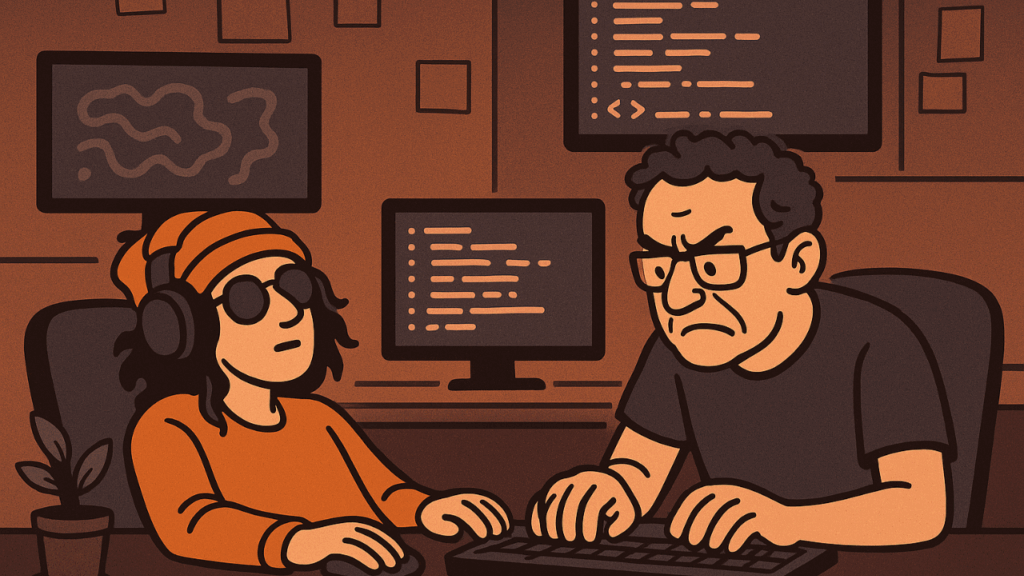Introduction: The Rise of Vibe Coding
In today’s fast-paced tech world, it’s easy to think that writing code equals being a software developer.
New programmers often rush into building things without solid fundamentals.
This trend, which I call “vibe coding,” is growing fast — and it’s dangerous.
Vibe coding is when developers throw code together based on what feels right, not based on real engineering principles.
No thought to maintainability.
No focus on testing.
No understanding of why certain patterns work and others don’t.
After 25 years in the trenches, I’ve seen the difference between real software development and random code dumping.
Real developers know that success isn’t about lines of code.
It’s about solving problems — and doing it simply.
Today, I’ll explain why real software development demands more than just “good vibes” at the keyboard.
What Is Vibe Coding?
Vibe coding is coding without discipline.
It’s building features that work… for now.
It’s focusing only on “it runs” rather than “it scales,” “it lasts,” or “others can understand it.”
Here are a few signs of vibe coding:
- Writing massive chunks of code without any plan.
- No clear separation of concerns.
- No meaningful comments or documentation.
- Little or no unit testing.
- Copy-pasting random solutions from Stack Overflow.
At first, vibe coding feels productive.
You see screens light up and buttons work.
But underneath, you’re building a fragile system that will break under real-world pressure.
In short, vibe coding is like building a skyscraper with Play-Doh.
It might look impressive today, but it’s not made to last.
Why Writing More Code Isn’t an Achievement
In many industries, producing more is better.
But in software development, writing more code can actually be harmful.
Every line you write:
- Must be tested.
- Must be maintained.
- Must be debugged when something breaks.
- Must be explained to future developers.
Writing 1000 lines of unnecessary code isn’t a win — it’s a debt.
It’s time your team will waste in the future trying to fix or understand it.
In my teams, I often tell developers:
“The best code you can write is no code at all.”
If you can solve a problem by removing code, refactoring, or choosing a simpler approach, you should.
Software development is not about feeding the machine more text.
It’s about designing efficient, elegant solutions that last.
The True Mark of a Senior Developer: Simplification
You can spot a senior developer by how they approach complexity.
Juniors often complicate things to look smart.
Seniors simplify things to be smart.
Real-world senior developers:
- Prefer small, readable functions over massive blocks.
- Ask “Do we even need this feature?” before coding.
- Favor battle-tested libraries over reinventing the wheel.
One of my favorite memories is a pull request where we deleted 1200 lines of messy code and replaced it with 200 lines of clean, well-documented code.
The system became faster, easier to test, and easier to onboard new devs onto.
Simplification is not laziness.
It’s craftsmanship.
It’s the result of deep understanding — knowing exactly how much you need and no more.
Pull Requests: Why Big Additions Should Raise Red Flags
When I review pull requests, huge additions without deletions worry me.
It usually means:
- The developer added complexity without questioning it.
- They may have duplicated existing functionality.
- They didn’t clean up obsolete code.
Good pull requests tell a story.
You see thoughtful changes.
You see code removed where no longer needed.
You see improvements, not just additions.
When you see:
- +5000 lines added
- +5 lines deleted
It’s not a badge of honor.
It’s a sign of technical debt accumulating at high speed.
Smart developers write less but achieve more.
Solving Problems with Less Code
The best software developers understand that less is more.
Here’s how they approach problems:
- Understand the problem deeply first.
They don’t jump into code immediately. - Reuse existing solutions.
They don’t invent new solutions unless absolutely necessary. - Focus on maintainability.
They write code that a future developer (or future themselves) can understand easily. - Think about the user.
They realize flashy code doesn’t matter if the product fails the user. - Document important decisions.
They write just enough documentation to explain why, not just how.
Simple code:
- Has fewer bugs.
- Is easier to test.
- Costs less to maintain.
- Evolves better with changing requirements.
Coding smartly isn’t about being lazy.
It’s about being strategic.

Conclusion: Stop Vibe Coding and Start Building Real Software
Vibe coding may give you short-term wins.
But if you want a long, successful career in tech, you need to move beyond it.
Real software development demands discipline.
It demands understanding architecture, design patterns, testing, and maintainability.
It rewards those who can solve problems with clarity and simplicity.
The best developers aren’t the ones adding 1000 lines a day.
They are the ones improving systems by removing complexity.
At StartupHakk, we believe that real progress comes not from chasing trends, but from mastering the fundamentals.
Whether you’re building a startup, leading a team, or coding your next big project, remember:
Real software development is about building things that work — and last.
Stop vibing. Start engineering.




